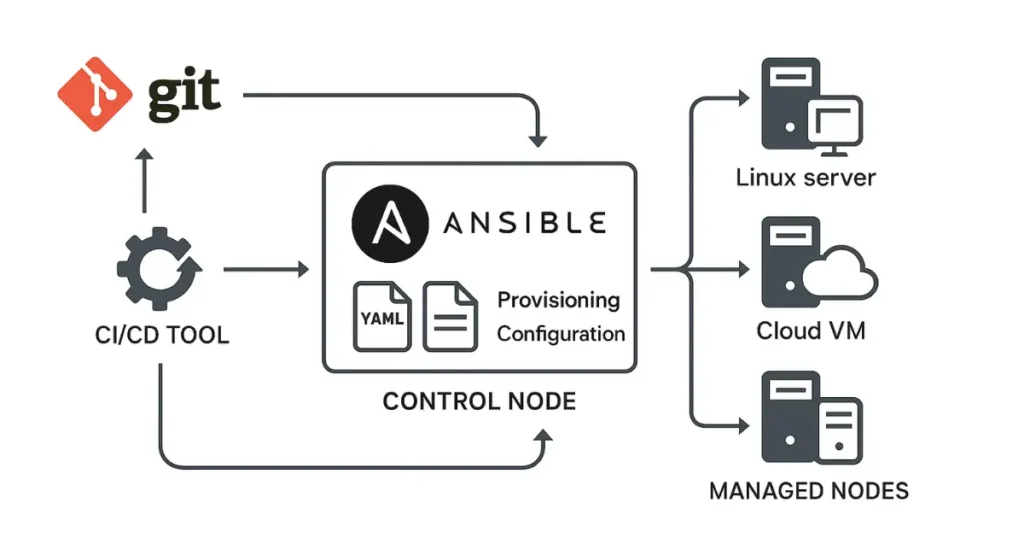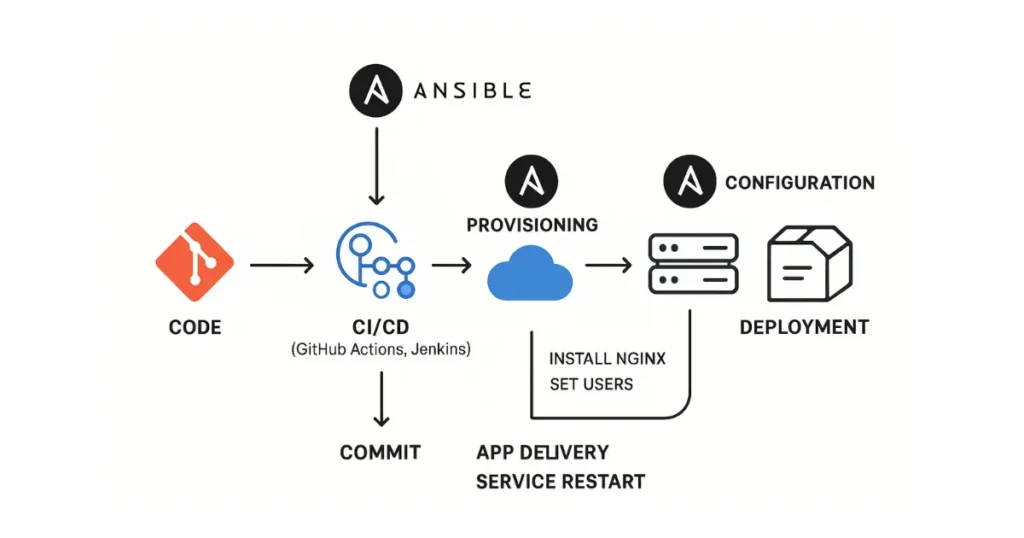Last Updated on 2 months by Sachin G
Automation isn’t just a buzzword in IT anymore — it’s survival. As teams scale and infrastructures grow complex, manually managing systems becomes error-prone and slow. That’s where DevOps practices and tools like Ansible come in. Automation is at the heart of this shift, and the Ansible tool stands out for its simplicity, power, and reliability.
This tutorial is for anyone wondering how to use Ansible for DevOps — whether you’re a system admin starting to automate tasks, a developer working with deployment pipelines, or a team aiming to embrace infrastructure as code.
In this article, we’ll explore why you should use Ansible for DevOps, how it helps with infrastructure as code, where it fits in CI/CD pipelines, and what lessons I learned while transitioning from a pure SysAdmin background to working in full-stack DevOps roles.
What is Ansible and How Does It Work in DevOps?
Ansible is an open-source IT automation tool developed by Red Hat. It’s agentless, uses YAML syntax, and connects over SSH, making it simple, powerful, and ideal for automating infrastructure.
Unlike older configuration management tools, Ansible doesn’t require you to install anything on the remote systems. You just define what needs to be done in YAML playbooks, and Ansible handles the rest.
For DevOps, it plays a key role in:
- Provisioning infrastructure
- Automating CI/CD pipelines
- Enabling infrastructure as code (IaC) strategies
- Scaling consistent environments across multiple servers

Why Should DevOps Teams Use Ansible?
When you’re managing dozens or even hundreds of servers, manual configuration becomes a liability. Ansible lets DevOps teams enforce consistency, speed up delivery cycles, and eliminate human error.
Here’s why Ansible should be in every DevOps toolkit:
- Simple, human-readable YAML files mean faster onboarding for new team members.
- It’s ideal for agentless automation — no extra software to install on client nodes.
- Supports continuous integration and continuous deployment out of the box.
- Can manage everything from Linux updates to cloud provisioning
Real-World Ansible Use Cases in DevOps
In a typical DevOps workflow, Ansible plays a central role in automating key stages once code changes are pushed to a repository. This begins when a developer commits code to a version control system like Git. That commit triggers a CI/CD pipeline managed by tools such as GitHub Actions, GitLab CI, or Jenkins.
Once the pipeline is active, Ansible steps in to provision the infrastructure. This means it automatically launches and configures servers or containers on cloud platforms like AWS, Azure, or even in local environments. This provisioning process ensures that the environment is ready for deployment with all necessary system requirements in place.
After provisioning, Ansible moves into the configuration management phase. Using YAML playbooks and roles, it installs packages, configures services (like Nginx, Docker, or database servers), manages user accounts, and applies security configurations such as firewall rules. These tasks are written as code, making them repeatable and scalable across environments.
Finally, Ansible handles the deployment of the application itself. It pulls the latest version of the code, sets environment variables, restarts necessary services, and verifies the deployment — all in an automated, consistent way.
This end-to-end workflow powered by Ansible not only saves time but also enforces Infrastructure as Code (IaC) best practices. Everything is version-controlled, traceable, and reproducible, which makes the entire process easier to scale, audit, and troubleshoot.

How Ansible Fits Into CI/CD Pipelines
Modern DevOps relies on CI/CD pipelines to ship code faster. Ansible helps automate the infrastructure layer, so developers can focus on building features.
Ansible can:
- Run post-build deployment scripts
- Configure staging/production environments
- Handle infrastructure provisioning during build steps
- Manage rollbacks via playbooks and roles
Tools like Ansible Tower offer visual interfaces and better role-based access control, ideal for enterprise-grade CI/CD pipelines.
ansible-core vs ansible-navigator Explained
ansible-core is the stripped-down engine — fast, minimal, CLI-driven.
ansible-navigator is a more user-friendly interface built for modern automation workflows.
While ansible-core is great for scripting, ansible-navigator supports easier playbook navigation, error inspection, and interactive debugging. Depending on your team’s maturity, you might use both — core for scripts, and navigator for visibility.
Key Takeaways: Use Ansible for DevOps Because…
✅ It’s beginner-friendly but scales to enterprise needs
✅ It supports infrastructure as code (IaC) best practices
✅ Works great for both provisioning with Ansible and app deployment
✅ Seamlessly integrates into CI/CD automation pipelines
✅ Enables repeatable, orchestration tools-friendly workflows
✅ Backed by Red Hat and the open-source community
Learn Smarter. Level Up Faster →
I’ve handpicked the best-rated Ansible courses on Udemy — all based on feedback, reviews, and real learning value. Start your DevOps journey with confidence.
Visit the Recommended Courses page to explore and enroll in courses trusted by the community.
See Curated Courses →Benefits of Ansible for SysAdmins, Developers, and DevOps Engineers
Whether you’re managing systems or building apps, Ansible offers benefits tailored to each role:
For System Administrators:
- Replace complex shell scripts with readable YAML playbooks
- Automate patching, updates, user management, and service configuration
- Manage remote server configurations without installing agents
Lesson learned: As a former SysAdmin, I spent hours logging into each server to do manual updates. My first Ansible playbook reduced that to one command — and it worked on 10+ servers instantly.
As for Developers:
- Trigger deployments from CI/CD pipelines
- Keep infrastructure definitions in the same repo as code
- Use Ansible to define and reproduce dev environments
DevOps Engineers:
- Use Ansible for provisioning infrastructure across clouds
- Automate tasks across the entire DevOps toolchain
- Create repeatable, reliable deployment patterns
Commonly Asked Questions (FAQ-style Add-on)
Absolutely. It integrates with CI tools and helps deploy infrastructure alongside code.
Yes — with more clarity, reusability, and control.
They can manage environments and automate deployments without relying solely on Ops.
Ansible integrates smoothly with CI/CD tools like Jenkins, GitHub Actions, GitLab CI, and Azure DevOps. You can use Ansible to:
Provision environments before a build or test
Deploy applications after a successful build
Run rollback tasks if something fails
Perform post-deployment checks or cleanups
CI/CD + Ansible = Automated, repeatable, and reliable deployment workflows.
Yes — Ansible is widely considered essential for modern DevOps engineers. It’s a core part of the infrastructure as code (IaC) toolkit, used by startups and large enterprises alike.
Reasons it’s a must-learn:
Reduces time to deploy and maintain systems
Fits naturally into Git-based workflows
Supports cloud automation across AWS, Azure, and GCP
Scales from one local VM to thousands of production servers

I’m Sachin Gupta — a freelance IT support specialist and founder of techtransit.org. I’m certified in Linux, Ansible, OpenShift (Red Hat), cPanel, and ITIL, with over 15 years of hands-on experience. I create beginner-friendly Linux tutorials, help with Ansible automation, and offer IT support on platforms like Upwork, Freelancer, and PeoplePerHour. Follow Tech Transit for practical tips, hosting guides, and real-world Linux expertise!
